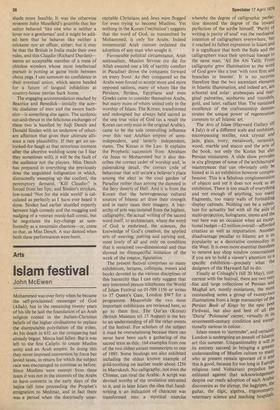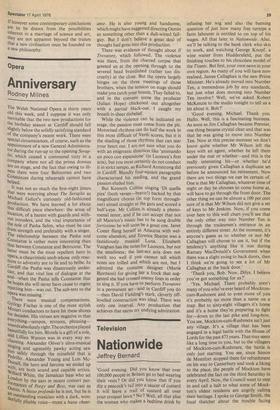Arts
Islam festival
John McEwen Mohammed was over forty when he became the self-proclaimed messenger of God (Allah), but in the remaining twenty years of his life he laid the foundation of an Arab religion rooted in the Judaeo-Christian beliefs of the higher civilisations to replace the disreputable polytheism of the tribes. At his death in 632 AD the conquering had already begun. Mecca had fallen. But it was left to the first Caliphs to create Muslim unity and an Arab empire. In doing this they never imposed conversion by force but levied taxes, in return for which the subject race was encouraged to continue as before. Since Muslims were exempt from these taxes it was not in the interests of the Arabs to have converts in the early days of the hejira (all time proceeding the Prophet's emigration to Medina), and in fact there was a period when the doctrinally unac
ceptable Christians and Jews were flogged for even trying to become Muslims. Yet nothing in the Koran ('recitation') suggests that the word of God, as transmitted by Mohammed, is only for Arabs. Indeed immemorial Arab custom ordained the adoption of any man who sought it.
Favourable political circumstance, Arab nationalism, Muslim fervour (to die for Allah ensured one a life of earthly comfort in Paradise) drove the conquests forward on every front. As they conquered so the Arabs were forced to accept more and more opposed nations, many of whom like the Persians, Syrians, Egyptians and even Greeks came to consider themselves Arabs, but many more of whom united only in the worship of Islam. The Koran, transformed and redesigned but always held sacred as the one true voice of God (as a result the Koran can only exist in the original Arabic), came to be the sole controlling influence over this vast Arabian empire of semiindependent, and latterly independent, states. The Koran is the Law. It explains the Prophetic succession from Abraham via Jesus to Mohammed but it also describes the correct order of worship and, in painstaking detail, the correct code of behaviour that will secure a believer's place among the elect in the cool garden of Paradise rather than among the damned in the fiery deserts of Hell. And it is from the Koran that the heterogeneous cultural sources of Islamic art draw their strength and in many cases their imagery. A hierarchy of arts was instated from the highest, calligraphy, the actual writing of the sacred word itself, to architecture, where the word of God is enshrined, the sciences, the knowledge of God's creation, the applied arts of weaving, potting and carving and, most lowly of all and only on condition that it remained two-dimensional and thus showed no disrespectful imitation of the work of the creator, figuration.
The present festival comprises so many exhibitions, lectures, colloquia, events and books devoted to the various disciplines of this hierarchy that I can only suggest that any interested person telephones the World of Islam Festival on 01-589 1156 or writes to 37 Queen's Gate, London SW7 for a programme. Meanwhile the two most important exhibitions are reviewed here, so go to them first. The Qur'an (Koran) (British Museum till 15 August) is the key to an understanding of all the other events of the festival. For scholars of the subject it must be overwhelming because there can never have been such a gathering of the sacred texts as this: 164 examples from one of the two oldest extant manuscripts to one of 1893. Some bindings are also exhibited including the oldest known example of gold-toothing on leather made about 1256 in Marrakesh. No calligraphy, not even the Chinese, can rival the Arabic. A script was devised worthy of the revelation entrusted to it, and in later Islam the idea that handwriting is an indication of character was transformed into a mystical exercise
whereby the degree of calligraphic perfection denoted the degree of the inward perfection of the scribe himself. 'Purity of writing is purity of soul' was the mediaeval intention of calligraphers everywhere, but it reached its fullest expression in Islam and it is significant that both the Sufis and the calligraphers trace their spiritual lineage to the same man, 'Ali ibn Abi Talib. From calligraphy grew illumination as the word of God grew like a tree 'with root firm and branches in heaven'. It is no _surprise therefore that the two ascendant elements in Islamic illumination, and indeed art, are arboreal and solar: arabesques and marginal palmettes, sunbursts and roundels, gold, and later, radiant blue. The sustained excellence of the craftsmanship demonstrates the unique power of regeneration common to all Islamic art.
The Arts of Islam (Hayward Gallery till 4 July) is of a different scale and ambition, encompassing textiles, rock crystal and jade, glass, ivory, metalwork, ceramics, wood, marble and stucco and the arts of the book, not only the Koran but also Persian miniatures. A slide show provides in situ glimpses of some of the architectural masterpieces that can obviously only be hinted at in an exhibition however comprehensive. This is a fabulous conglomeration of objects and yet it does not work as an exhibition. There is too much of everything and not enough of anything, too manY fragments, too many walls of forbidding display cabinets. Nothing can be a substitute for actuality but with all the aids of multi-projection, holograms, stereo and the rest here was an occasion when an exceptional budget—£2 million overall—afforded creation as well as importation. Another disadvantage peculiar to Islamic art is its popularity as a decorative commodity 51 the West. It is even more essential therefore to remove any shop window connotations if you are to hold a viewer's attention to a specific exhibition—precisely what the designers of the Hayward fail to do.
Finally at Colnaghi's (till 20 May), concurrent with the festival, there are two very fine and large collections of Persian and Mughal art, mostly miniatures, the most outstanding series a group of twenty-two illustrations from a large manuscript of the Persian Book of Kings by the epic Poet Firdwasi, but also and best of all the `Doria"Polonaise' carpet, virtually in its seventeenth-century condition and excePtionally various in colour. Islam means to 'surrender', and certainly London is undergoing an assault of Islamc art this summer. Unquestionably it will in its entirety succeed in bringing a greater understanding of Muslim culture to malt who at present remain ignorant of it an this is good, because for too long in EuroPe religious (and Voltairian) prejudice has, militated against that acknowledgemen' despite our ready adoption of such Arabic discoveries as the stirrup, the bagpipes, the guitar, the digit, algebra, trigonometrY' veterinary science and teaching hospitals'
If however some contemporary conclusions are to be drawn from the possibilities inherent in a marriage of science and art, they are not apparent beyond the truism that a new civilisation must be founded on a new philosophy.



































 Previous page
Previous page